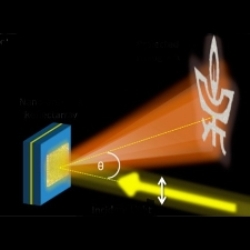Jul 10 2014
Tel Aviv University researchers develop holography technology that could change the way we view the world
Since the 1960s, theatergoers have shelled out for crude 3-D glasses, polarized glasses, and shutter glasses to enhance their viewing experience. These basic devices, used to trick the brain into perceiving an artificial three-dimensional reality, may soon be rendered obsolete with the introduction of new holography technology developed by Tel Aviv University researchers.

TAU doctoral students Yuval Yifat, Michal Eitan, and Zeev Iluz have developed highly efficient holography based on nanoantennas that could be used for security as well as medical and recreational purposes. Prof. Yael Hanein, of TAU's School of Electrical Engineering and head of TAU's Center for Nanoscience and Nanotechnology, and Prof. Jacob Scheuer and Prof. Amir Boag of the School of Electrical Engineering, led the development team. Their research, published in the American Chemical Society's publication Nano Letters, uses the parameters of light itself to create dynamic and complex holographic images.
In order to effect a three-dimensional projection using existing technology, two-dimensional images must be "replotted" — rotated and expanded to achieve three-dimension-like vision. But the team's nanoantenna technology permits newly designed holograms to replicate the appearance of depth without being replotted. The applications for the technology are vast and diverse, according to the researchers, who have already been approached by commercial entities interested in the technology.
Taking out the map
"We had this interesting idea — to play with the parameters of light, the phase of light," said Mr. Yifat. "If we could dynamically change the relation between light waves, we could create something that projected dynamically — like holographic television, for example. The applications for this are endless. If you take light and shine it on a specially engineered nanostructure, you can project it in any direction you want and in any form that you want. This leads to interesting results."
The researchers worked in the lab for over a year to develop and patent a small metallic nanoantenna chip that, together with an adapted holography algorithm, could determine the "phase map" of a light beam. "Phase corresponds with the distance light waves have to travel from the object you are looking at to your eye," said Prof. Hanein. "In real objects, our brains know how to interpret phase information so you get a feeling of depth, but when you look at a photograph, you often lose this information so the photographs look flat. Holograms save the phase information, which is the basis of 3-D imagery. This is truly one of the holy grails of visual technology."
According to the researchers, their methodology is the first of its kind to successfully produce high-resolution holographic imagery that can be projected efficiently in any direction.
"We can use this technology to reflect any desired object," said Prof. Scheuer. "Before, scientists were able to produce only basic shapes — circles and stripes, for example. We used, as our model, the logo of Tel Aviv University, which has a very specific design, and were able to achieve the best results seen yet."
The key to complex imagery
"This can be used for scientific research, security, medical, engineering, and recreational purposes," said Prof. Scheuer. "Imagine a surgeon, who is forced to replot several CAT-SCAN images to generate an accurate picture. By generating just one holographic image, she could examine symptoms from every angle. Similarly, an architect could draw up a holographic blueprint that he could actually walk through and inspect. The applications are truly endless."
The new technology could also be used to improve laser-based radars used for military purposes as well as advance anti-counterfeiting techniques that safeguard against theft.
"We optimized holograms to the highest resolution and created a new methodology able to produce any arbitrary image," said Prof. Scheuer. "Everything was done here, at the facilities of Tel Aviv University Center for Nanoscience and Nanotechnology; including the fabrication, characterization and experiments."
The researchers are currently developing technology that will allow holographic images to change shape and move.